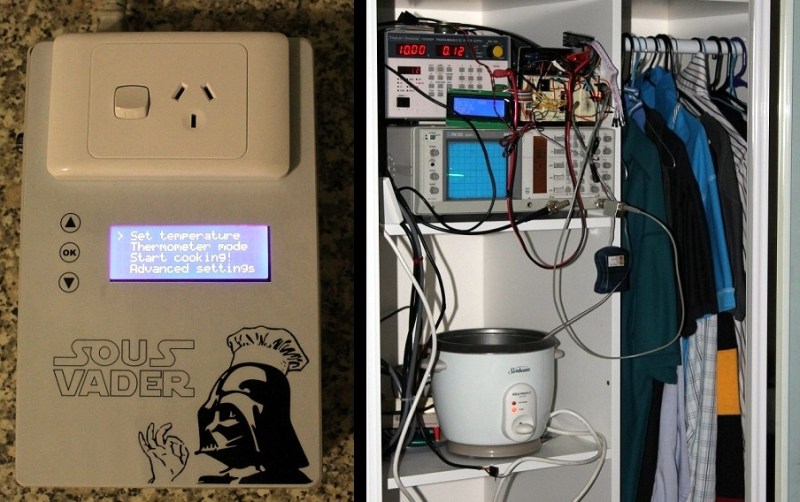[Craig] pulled off a beautiful build with his Sous Vader project. The name is a geeky spin on sous vide, a method of cooking foods in water held at a precise temperature. Building your own setup at home saves a ton of money, but it’s also a lot of fun. This explains the frequency with which we see these builds here at Hackaday.
So this one has a flashy name, a fine-looking case, but the beauty continues on the internals. [Craig] posted an image with the cover off of the control unit and it’s absolutely gorgeous inside. Part of the reason for this is the circuit board he spun for the project which hosts the ATmega328 and interfaces with the LCD, buttons, temperature sensor, and mains-switching triac. But most of the credit is due to his attention to detail. The image on the right shows him prototyping the hardware. Since some of his meals take 20 hours to prepare it’s no wonder he found an out-of-the-way closet in which to do the testing.
Make sure to read all the way to the bottom of the post for some cooking tips. For instance, since he doesn’t have a vacuum sealer he uses zipper bags — lowering them into water to push out the air as they are sealed.















Why not just boil the water? I think the temperature of water remains constant during phase change. Although you only get 1 temperature.
Typically sous-vide is done at lower temperatures (much less than boiling water), part of the point is that you can set the temperature so only have one temperature isn’t very useful.
Too hot. This is a slow-cooking method and you usually want to keep the temp steady at 130-140 degrees F.
Because the point of a sous vide machine is to keep the water at a specific temperature where the temperature you want to keep it at depends on exactly what you’re cooking and what effect you’re going for. Generally, boiling is well beyond the typical temperatures desired.
Because sometimes you want to be able to cook meat slowly at one constant temperature that isn’t boiling?
I think decreasing pressure below atmospheric would give you a lower boiling point. I’m not saying that would be a better/easier way; and I don’t know how much of a vacuum you’d have to create but I suppose it would be an alternative way.
it’s also not as easy as hooking an arduino up to a crockpot
You’d have to reduce the pressure to 1/10 of one atmosphere to reduce the boiling point in half. You’d also have to constantly replace water lost by evaporation (maybe by re-condensing the steam) since you couldn’t completely seal the pot (or else the pressure would rise).
As a fan of puns, this one gets my vote!
Same here. Can’t stop laughing at the graphic with Vader and the little “perfecto” hand. Nice, witty build :)
I came here to say the same thing
Yea except they mis-spelled the title and partially ruined it.
vadAr?
The ability to cook a perfect medium-rare steak is insignificant next to the power of the force.
I find your lack of heat … disturbing.
I have altered the meal. Pray I do not alter it further.
+2!!
many midchloridians will grow, unless you have excellent kitchen hygiene and use fresh produce
Ah, a hot nutritious meal for you I have..
Re. bugs. My understanding was that most if not all of the really nasty ones get owned at more than 45 Celsius as the DNA can’t stand the high temperature.
Some toxins such as those produced by reheating stored rice need way more than this, so best to be very careful during preparation.
I’ve run into this before, and it isn’t pleasant so best to err on the side of caution and precook any fresh produce first.
Your understanding is completely wrong. 45C and you die. Read this.
http://www.douglasbaldwin.com/sous-vide.html#Safety
You are about 10C too low. Above the minimum, it becomes a time vs temperature thing.
Great name, nice write-up. But I’m wondering: has someone an idea how much energy you have to put to prepare an average meal sous-vide style? Or how it compares to regular cooking? And has insulation of the cooker been succesful?
It’s not all that energy intensive. I’m currently doing some pork at 61dC, and it’s using about 8% of the full 350W power output to keep it there. So ignoring the digital board for a moment, that’s about 30W continuous (and I plan to leave it going for about 40 hours).
Were you concerned about reducing the energy use, you could probably improve on that by beefing up the insulation (wrapping it with towels? sitting it in a polystyrene box?)
Thanks for the info, and again: nice job. Inspiring.